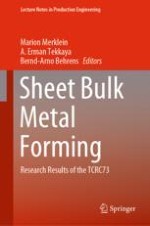This book presents the findings of research projects from the Transregional Collaborative Research Centre 73. These proceedings are the result of years of research into sheet–bulk metal forming.
The book discusses the challenges posed by simulating sheet–bulk metal forming. It takes into account the different phenomena characteristic to both sheet and bulk forming fields, and explores the demands this makes on modelling the processes. It then summarizes the research, and presents from a practitioner's point of view. This means the book is of interest to and helps both academics and industrial engineers within the field of sheet–bulk metal forming.
